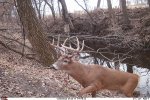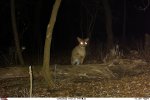I'm just using MS access as the engine and created my own. I have an excel spreadsheet with a VBA macro that reads the EXIF data from each picture and extracts the location, date, and time stamp and a link to the jpeg picture. This list is imported into my MS Access database. This DB is also used by ARCGIS. It has all of the data associated with the property. Once the dataset has been imported into the DB, I have an Access form that presents each picture along with the data. I then add the specific animals in each picture to each record.
Since I have partners at the farm, I then run a macro that FTPs all of the pictures to a web server and copies the Access records to an MSSQL database. We have a private web site that I and my partners can access. They can look at all of the pictures as well as maps of the farm with food plot, tree stand locations, and such. The web site does some database queries to create charts. We do survival surveys Jan through Apr and then a recruitment in Sep. Those picture counts are compared from year to year along with our harvest statics and such on the web site.
So, I actually have a duplicate of the database. Having the second copy is also assurance that if my web server would die or something, I would still have the MS access database with all the data.
Thanks,
Jack



